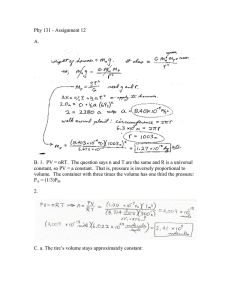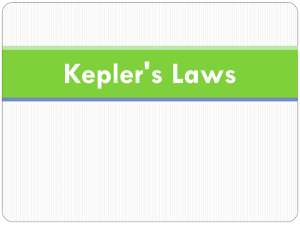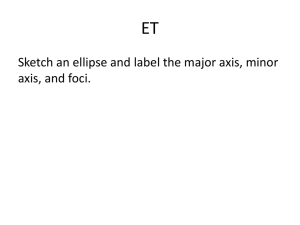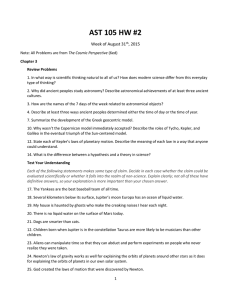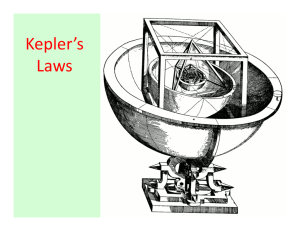Resonance In the Solar System Steve Bache Spring 2012
advertisement
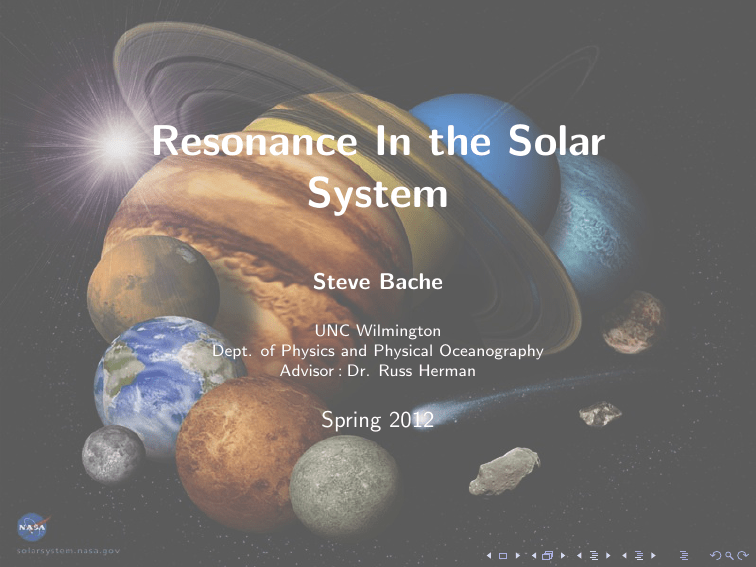
Resonance In the Solar System Steve Bache UNC Wilmington Dept. of Physics and Physical Oceanography Advisor : Dr. Russ Herman Spring 2012 Goal • numerically investigate the dynamics of the asteroid belt • relate old ideas to new methods • reproduce known results History The role of science: • make sense of the world • perceive order out of apparent randomness History The role of science: • make sense of the world • perceive order out of apparent randomness • the sky and heavenly bodies Anaximander (611-547 BC) • Greek philosopher, scientist • stars, moon, sun 1:2:3 Figure: Anaximander’s Model Pythagoras (570-495 BC) • Mathematician, philosopher, started a religion • all heavenly bodies at whole number ratios • ”Harmony of the spheres” Figure: Pythagorean Model Tycho Brahe (1546-1601) • Danish astronomer, alchemist • accurate astronomical observations, no telescope • importance of data collection Johannes Kepler (1571-1631) • Brahe’s assistant • Used detailed data provided by Brahe • Observations led to Laws of Planetary Motion Johannes Kepler (1571-1631) • Brahe’s assistant • Used detailed data provided by Brahe • Observations led to Laws of Planetary Motion • orbits are ellipses • equal area in equal time • T 2 ∝ a3 Kepler’s Model • Astrologer, Harmonices Mundi • Used empirical data to formulate laws Figure: Kepler’s Model Isaac Newton (1642-1727) • religious, yet desired a physical mechanism to explain Kepler’s laws • contributions to mathematics and science • Principia • almost entirety of an undergraduate physics degree • Law of Universal Gravitation ~ 12 = −G m1 m2 r̂12 . F |r12 |2 Resonance • Transition from ratios/ integer spacing to more physical description, resonance plays a key role in celestial mechanics Resonance • Transition from ratios/ integer spacing to more physical description, resonance plays a key role in celestial mechanics • Commensurability The property of two orbiting objects, such as planets, satellites, or asteroids, whose orbital periods are in a rational proportion. Resonance • Commensurability The property of two orbiting objects, such as planets, satellites, or asteroids, whose orbital periods are in a rational proportion. • Resonance Orbital resonances occur when the mean motions of two or more bodies are related by close to an integer ratio of their orbital periods Examples • Pluto-Neptune 2:3 • Ganymede-Europa-Io 1:2:4 Examples Cassini division in Saturn’s rings 1:2 Resonance with Mimas Kirkwood Gaps Daniel Kirkwood (1886) Kirkwood Gaps • Commensurability in the orbital periods cause an ejection by Jupiter • explanation provided by Kirkwood, using 100 asteroids • now thought to exhibit chaotic change in eccentricity My Goal • To create a simulation of the interactions of Jupiter, the Sun, and ’test’ asteroids • Integrate Newton’s equations of motion in MATLAB over a large time span (≈ 1MY ) Requirements 1 an idea for what causes orbital resonance 2 an appropriate integrating scheme 3 initial conditions for all bodies being considered Requirements 1 an idea for what causes orbital resonance 2 an appropriate integrating scheme 3 initial conditions for all bodies being considered • Start with the Kepler problem Kepler Problem • The problem of two bodies interacting only by a central force is known as the Kepler Problem • Also known as the 2-body problem Kepler Problem m1 m2 m1 m2 (r1 − r2 ) =G 2 3 r12 r12 m1 m2 m1 m2 (r2 − r1 ) m2 r¨2 = G 2 = G 3 r12 r12 m1 r¨1 = G Center of Mass is stationary/ moves at constant velocity Classic treatment r¨2 − r¨1 = r̈ r r̈ + µ 3 = 0 r G (m1 + m2 ) = µ Classic treatment Considering motion of m2 with respect to m1 gives: r × r̈ = 0, which, integrating once, gives r × ṙ = h This implies that the motion in the two-body problem lies in a plane. Treat this relative motion in polar coordinates (r,θ). Polar form Using, r = rr̂ ṙ = rr̂ + r θ̇θ̂ 1d 2 (r θ̇) θ̂, r̈ = (r̈ − r θ̇)r̂ + r dt one finds the solution: r (θ) = where p = h2 µ. p , 1 + e cos(θ) Elliptical Orbit Figure: Axes of an ellipse, Eccentricity = c a Kepler’s Laws 1 The motion of m2 is an ellipse with m1 at one focus 2 dA dt = h 2 = constant Figure: Kepler’s 2nd Law Kepler’s third law h • From Kepler’s second law, we have dA dt = 2 . • area of ellipse = A = πab A • τ = dA dt 3 τ2 = 4π 2 a3 µ , or τ 2 ∝ a3 . N-Body Problem • no analytical solutions for N>2 • computational methods → Euler’s method, Runge-Kutta N-Body Problem • no analytical solutions for N>2 • computational methods → Euler’s method, Runge-Kutta • need a better method System • N bodies - Sun, Jupiter, asteroids • centralized force • kinetic and potential energies independent • Hamiltonian system Hamiltonian Formulation H(q, p) = T (p) + U(q) q̇ = ṗ = ∂H ∂p −∂H ∂q N-Body Hamiltonian • Hamiltonian is separable, i.e. H = H(q, p, t) = T (p) + U(q) n 1 X pi2 T = 2 mi i=1 U=− N X i−1 X Gmi mj |q1 − qj | i=2 j=1 N-Body Hamiltonian • from Hamilton equations: q̇i = ∇pi H = pi mi ṗi = ∇qi H = −Gmi n X mj (qi − qj ) j6=i |qi − qj |3 Numerical Scheme • best approach → symplectic integrator • designed for solutions to Hamiltonian systems • preserves volume in phase space Derivation To derive the simplectic integrator to be used, compose Euler method map qi+1 = qi + dt∇pi H pi+1 = pi − dt∇qi+1 H with its adjoint pi+1 = pi − dt∇qi H qi+1 = qi + dt∇pi+1 H by introducing a ”half time step” i + 1 2 of size dt 2. Derivation New integrating scheme is now qi+ 1 = qi + 2 dt ∇pi H 2 pi+1 = pi − dt∇qi+ 1 H 2 qi+1 = qi+ 1 2 dt + ∇pi+1 H. 2 Leapfrog Algorithm • additional half time-step transforms Euler’s method to symplectic integrator • more stable over long integrations • angular momentum is preserved explicitly Leapfrog Algorithm • additional half time-step transforms Euler’s method to symplectic integrator • more stable over long integrations • angular momentum is preserved explicitly • a simple test of the Leapfrog integrator → Leapfrog Test Figure: Theoretical Solution Leapfrog Test Figure: Numerical Solution So far... • semi-major axis/ orbital period relationship necessary for resonance • appropriate integrating scheme Unresolved... • Initial conditions for Sun, Jupiter, asteroids Initial Conditions • Positions • sun at origin • Jupiter at aphelion • asteroids at perihelion • Velocities (from ṙ · ṙ ) 2 1 v =µ − r a 2 Model • Integrate orbits of the Sun, Jupiter, and five asteroids • range of initial semi-major axes, e = 0.15 • initial postions • Sun at origin • Jupiter at aphelion • asteroids at perihelion • calculate eccentricities and semi-major axis Results Figure: 3:1 Resonance - 10K Jupiter Years - ∆t = 10.83 days Results Figure: 3:1 Resonance - 10K Jupiter Years - ∆t = 10.83 days Results Figure: 3:1 Resonance - 100K Jupiter Years - ∆t = 10.83 days Results Figure: 3:1 Resonance - 100K Jupiter Years - ∆t = 10.83 days Results Figure: 3:1 Resonance - 100K → 200K Jupiter Years - ∆t = 10.83 days Results Figure: 3:1 Resonance - 100K → 200K Jupiter Years - ∆t = 10.83 days Further Abstraction Conclusion • resonances play a key role • unite pre-scientific revolution → modern science • increased computational power → insights into development of solar system References 1 2 3 4 5 6 7 Meteorites may follow a chaotic route to Earth, Wisdom, Nature 315, 731-733 (27 June 1985) The origin of the Kirkwood gaps - A mapping for asteroidal motion near the 3/1 commensurability, Wisdom, Astronomical Journal, vol 87, Mar. 1982 Numerical Investigation of Chaotic Motion in the Asteroid Belt, Danya Rose, University of Sydney Honours Thesis, November 2008 Motion of Asteroids at the Kirkwood Gaps, Makoto Yoshikawa, Icarus, Vol. 87, 1990 The role of chaotic resonances in the Solar System, N. Murray and M. Holman, Nature, vol. 410, 12 April 2001 Introduction to Celestial Mechanics, Jean Kovalevsky, D. Reidel, 1967 Classical Mechanics, John R. Taylor

